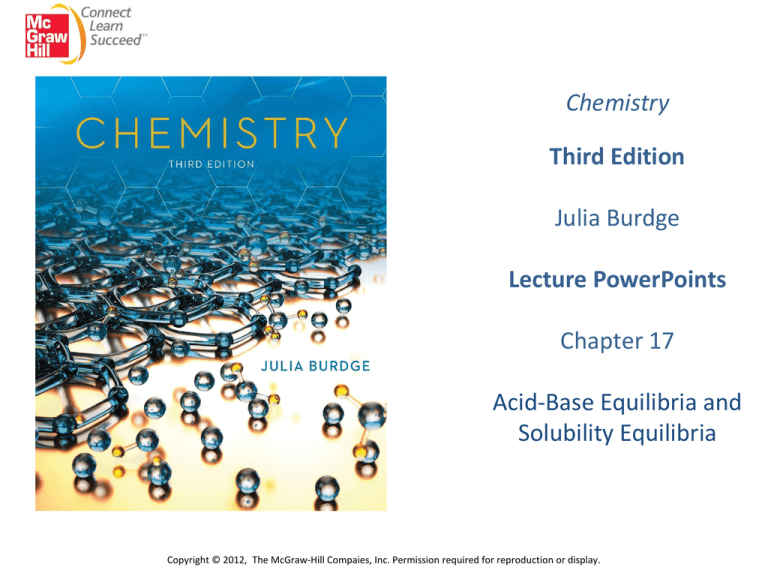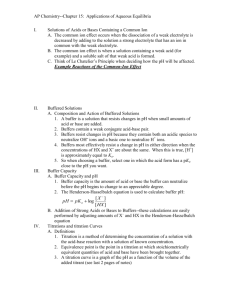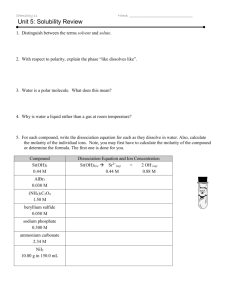Chapter 17
advertisement

Chemistry Third Edition Julia Burdge Lecture PowerPoints Chapter 17 Acid-Base Equilibria and Solubility Equilibria Copyright © 2012, The McGraw-Hill Compaies, Inc. Permission required for reproduction or display. CHAPTER 17.1 17.2 17.3 17.4 17.5 17.6 17 Acid-Base Equilibria and Solubility Equilibria The Common Ion Effect Buffer Solutions Acid-Base Titrations Solubility Equilibria Factors Affecting Solubility Separation of Ions Using Differences in Solubility 2 17.1 The Common Ion Effect Topics The Common Ion Effect 3 17.1 The Common Ion Effect The Common Ion Effect Let’s examine how the properties of a solution change when a second solute is introduced. Consider a liter of solution containing 0.10 mole of acetic acid. [H3O+] = [CH3COO‒] = 1.34 × 10‒3 M and pH = 2.87 4 17.1 The Common Ion Effect The Common Ion Effect Now consider what happens when we add 0.050 mole of sodium acetate (CH3COONa) to the solution. 5 17.1 The Common Ion Effect The Common Ion Effect In general, when a compound containing an ion in common with a dissolved substance is added to a solution at equilibrium, the ionization equilibrium shifts to the left. This phenomenon is known as the common ion effect. The common ion can also be H3O+ or OH–. 6 SAMPLE PROBLEM 17.1 Determine the pH at 25°C of a solution prepared by adding 0.050 mole of sodium acetate to 1.0 L of 0.10 M acetic acid. (Assume that the addition of sodium acetate does not change the volume of the solution.) 7 SAMPLE PROBLEM 17.1 Setup We use the stated concentration of acetic acid, 0.10 M, and [H3O+] 0 M as the initial concentrations in the ice table. Solution 8 SAMPLE PROBLEM 17.1 x = 3.6 × 10‒5 M. [H3O+] = x, so pH = ‒log (3.6 × 10‒5) = 4.44 The common ion effect has shifted the ionization of acetic acid to the left. 9 17.2 Buffer Solutions Topics Calculating the pH of a Buffer Preparing a Buffer Solution with as Specific pH 10 17.2 Buffer Solutions Calculating the pH of a Buffer A solution that contains a weak acid and its conjugate base (or a weak base and its conjugate acid) is a buffer solution or simply a buffer. A buffer’s ability to convert a strong acid to a weak acid minimizes the effect of the addition on the pH : 11 17.2 Buffer Solutions Calculating the pH of a Buffer A buffer’s ability to convert a strong base to a weak base minimizes the effect of the addition on the pH : 12 17.2 Buffer Solutions Calculating the pH of a Buffer Suppose that we have 1 L of the acetic acid-sodium acetate solution: 13 17.2 Buffer Solutions Calculating the pH of a Buffer 14 17.1 The Common Ion Effect Calculating the pH of a Buffer Consider what happens when we add 0.10 mole of HCl to the buffer. (We assume that the addition of HCl causes no change in the volume of the solution.) 15 17.1 The Common Ion Effect Calculating the pH of a Buffer A change of only 0.08 pH units. 16 17.1 The Common Ion Effect Calculating the pH of a Buffer Had we added 0.10 mol of HCl to 1 L of pure water, the pH would have gone from 7.00 to 1.00! 17 17.2 Buffer Solutions Calculating the pH of a Buffer In the determination of the pH of a buffer, we always neglect the small amount of weak acid that ionizes (x) because ionization is suppressed by the presence of a common ion. Similarly, we ignore the hydrolysis of the acetate ion because of the presence of acetic acid. This enables us to derive an expression for determining the pH of a buffer. 18 17.2 Buffer Solutions Calculating the pH of a Buffer 19 17.2 Buffer Solutions Calculating the pH of a Buffer Henderson-Hasselbalch equation 20 SAMPLE PROBLEM 17.2 Starting with 1.00 L of a buffer that is 1.00 M in acetic acid and 1.00 M in sodium acetate, calculate the pH after the addition of 0.100 mole of NaOH. (Assume that the addition does not change the volume of the solution.) Strategy Added base will react with the acetic acid component of the buffer, converting OH‒ to CH3COO‒ : CH3COOH(aq) + OH‒(aq) → H2O(l) + CH3COO‒(aq) 21 SAMPLE PROBLEM 17.2 Setup Solution Thus, the pH of the buffer after addition of 0.10 mol of NaOH is 4.83. 22 17.2 Buffer Solutions Preparing a Buffer Solution with as Specific pH A solution is only a buffer if it has the capacity to resist pH change when either an acid or a base is added. If the concentrations of a weak acid and conjugate base differ by more than a factor of 10, the solution does not have this capacity. 23 17.2 Buffer Solutions Preparing a Buffer Solution with as Specific pH Therefore, we consider a solution a buffer, and can use to calculate its pH, only if the following condition is met: Consequently, the log term can only have values from –1 to 1, and the pH of a buffer cannot be more than one pH unit different from the pKa of the weak acid it contains. 24 17.2 Buffer Solutions Preparing a Buffer Solution with as Specific pH This is known as the range of the buffer, where pH = pKa 1. This enables us to select the appropriate conjugate pair to prepare a buffer with a specific, desired pH. 25 17.2 Buffer Solutions Calculating the pH of a Buffer To prepare a buffer with a specific, desired pH: 1. Choose a weak acid whose pKa is close to the desired pH. 26 17.2 Buffer Solutions Calculating the pH of a Buffer 2. Substitute the pH and pKa values into the following equation to obtain the necessary ratio of [conjugate base]/[weak acid]. 27 SAMPLE PROBLEM 17.3 Select an appropriate weak acid from the table, and describe how you would prepare a buffer with a pH of 9.50. 28 SAMPLE PROBLEM 17.3 Setup Two of the acids listed in the table have pKa values in the desired range: hydrocyanic acid (HCN, pKa = 9.31) and phenol (C6H5OH, pKa = 9.89). 29 SAMPLE PROBLEM 17.3 Solution One way to achieve this would be to dissolve 0.41 mol of C6H5ONa and 1.00 mol of C6H5OH in 1 L of water. 30 17.3 Acid‒Base Titrations Topics Strong Acid-Strong Base Titrations Weak Acid-Strong Base Titrations Strong Acid-Weak base Titrations Acid-Base Indicators 31 17.3 Acid‒Base Titrations Strong Acid-Strong Base Titrations The titrant is the solution that is added from the burette. 32 17.3 Acid‒Base Titrations Strong Acid-Strong Base Titrations Titration curve (pH as a function of volume titrant added) of a strong acid-strong base titration. 33 17.3 Acid‒Base Titrations Strong Acid-Strong Base Titrations Consider the addition of a 0.100 M NaOH solution (from a burette) to a vessel containing 25.0 mL of 0.100 M HCl. 34 17.3 Acid‒Base Titrations Strong Acid-Strong Base Titrations Calculate the pH of the solution at every stage of titration. Prior to the addition of base: Simply calculate the pH of a strong acid: ‒log [H3O+] . Here, the pH of the acid is given by ‒log (0.100), or 1.00 35 17.3 Acid‒Base Titrations Strong Acid-Strong Base Titrations Before the equivalence point: Consider the addition of 10.0 mL of 0.100 M NaOH to 25.0 mL of 0.100 M HCl. Note: Using millimoles instead of moles simplifies the calculations. Remember that millimoles = M × mL 36 17.3 Acid‒Base Titrations Strong Acid-Strong Base Titrations Before the equivalence point: The total volume of the solution is 35.0 mL. The number of millimoles of NaOH in 10.0 mL is 37 17.3 Acid‒Base Titrations Strong Acid-Strong Base Titrations The number of millimoles of HCl originally present is The amount of HCl left after partial neutralization is 2.50 ‒ 1.00, or 1.50 mmol. 38 17.3 Acid‒Base Titrations Strong Acid-Strong Base Titrations Next, determine [H3O+]. We have 1.50 mmol in 35.0 mL: Thus [H3O+] = 0.0429 M, and the pH of the solution is pH = ‒log (0.04289) = 1.37 39 17.3 Acid‒Base Titrations Strong Acid-Strong Base Titrations At the equivalence point: Consider the addition of 25.0 mL of 0.100 M NaOH to 25.0 mL of 0.100 M HCl. This is a complete neutralization reaction. [H3O+] = [OH‒] = 1.00 × 10‒7 M and the pH of the solution is 7.000. 40 17.3 Acid‒Base Titrations Strong Acid-Strong Base Titrations After the equivalence point: Consider the addition of 35.0 mL of 0.100 M NaOH to 25.0 mL of 0.100 M HCl. The total volume of the solution is now 60.0 mL. The number of millimoles of NaOH added is 41 17.3 Acid‒Base Titrations Strong Acid-Strong Base Titrations There are 2.50 mmol of HCl in 25.0 mL of solution. 2.50 mmol of NaOH have been consumed, and there are 3.5 ‒ 2.5 or 1.00 mmol of NaOH remaining. The [NaOH] in 60.0 mL of solution is 42 17.3 Acid‒Base Titrations Strong Acid-Strong Base Titrations [OH‒] = 0.0167 M and pOH = ‒log (0.0167) = 1.78. The pH of the solution is 14.00 ‒ 1.78 or 12.22. 43 17.3 Acid‒Base Titrations Strong Acid-Strong Base Titrations 44 17.3 Acid‒Base Titrations Weak Acid-Strong Base Titrations Titration curve of a weak acid-strong base titration: Strong-acid/strong-base curve, for comparison) 45 17.3 Acid‒Base Titrations Weak Acid-Strong Base Titrations Consider the neutralization reaction between acetic acid (a weak acid) and sodium hydroxide (a strong base): 46 17.3 Acid‒Base Titrations Weak Acid-Strong Base Titrations Prior to the addition of base: The pH is determined by the ionization of acetic acid. Use concentration (0.10 M) and Ka (1.8 × 10‒5) to calculate the [H3O+]: 47 17.3 Acid‒Base Titrations Weak Acid-Strong Base Titrations 48 17.3 Acid‒Base Titrations Weak Acid-Strong Base Titrations Solving for x, gives [H3O+] = 1.34 × 10‒3 M and pH = 2.87 49 17.3 Acid‒Base Titrations Weak Acid-Strong Base Titrations Before the equivalence point: After the first addition of base, some of the acetic acid has been converted to acetate ion via the reaction 50 17.3 Acid‒Base Titrations Weak Acid-Strong Base Titrations The solution is a buffer and we use the Henderson-Hasselbalch equation to calculate the pH. After the addition of 10.0 mL of base, the solution contains 1.5 mmol of acetic acid and 1.0 mmol of acetate ion 51 17.3 Acid‒Base Titrations Weak Acid-Strong Base Titrations At the equivalence point: All the acetic acid has been neutralized and we are left with acetate ion in solution. pH is determined by the concentration and the Kb of acetate ion. 52 17.3 Acid‒Base Titrations Weak Acid-Strong Base Titrations The equivalence point occurs when 25.0 mL of base has been added, making the total volume 50.0 mL. The 2.5 mmol of acetic acid has all been converted to acetate ion. 53 17.3 Acid‒Base Titrations Weak Acid-Strong Base Titrations The Kb for acetate ion is 5.6 × 10‒10. 54 17.3 Acid‒Base Titrations Weak Acid-Strong Base Titrations Solving for x, gives [OH‒] = 5.3 × 10‒6 M, pOH = 5.28, and pH = 8.72 55 17.3 Acid‒Base Titrations Weak Acid-Strong Base Titrations After the equivalence point: The curve for titration of a weak acid with a strong base is identical to the curve for titration of a strong acid with a strong base. Because all the acetic acid has been consumed, there is nothing in solution to consume the additional added OH‒, and the pH levels off between 12 and 13. 56 17.3 Acid‒Base Titrations Weak Acid-Strong Base Titrations 57 SAMPLE PROBLEM 17.4 Calculate the pH in the titration of 50.0 mL of 0.120 M acetic acid by 0.240 M sodium hydroxide after the addition of (a) 10.0 mL of base, (b) 25.0 mL of base, and (c) 35.0 mL of base. Strategy The reaction is 58 SAMPLE PROBLEM 17.4 Setup a) The solution originally contains (0.120 mmol/mL)(50.0 mL) = 6.00 mmol of acetic acid. 59 SAMPLE PROBLEM 17.4 Solution a) Prior to the equivalence point, the solution is a buffer. We use the Henderson-Hasselbalch equation. 60 SAMPLE PROBLEM 17.4 b) After the addition of 25.0 mL of base, the titration is at the equivalence point. Calculate the pH using the concentration and the Kb of acetate ion. 61 SAMPLE PROBLEM 17.4 The total volume 50.0 mL + 25.0 mL = 75.0 mL. The concentration of acetate ion is 62 SAMPLE PROBLEM 17.4 x = [OH‒], so [OH‒] = 6.7 × 10‒6 M pOH = –log (6.7 × 10‒6) = 5.17 and pH = 14.00 ‒ 5.17 = 8.83. 63 SAMPLE PROBLEM 17.4 A 35.0 mL amount of the base contains (0.240 mol/mL)(35.0 mL) = 8.40 mmol of OH‒. c) After the addition of 35.0 mL of base, the titration is past the equivalence point and we solve for pH by determining the concentration of excess hydroxide ion. 8.40 ‒ 6.00 = 2.40 mmol of excess OH‒ 64 SAMPLE PROBLEM 17.4 The total volume is 50.0 + 35.0 = 85.0 mL. [OH‒] = 2.40 mmol/85.0 mL = 0.0280 M pOH = ‒log (0.0280) = 1.553 pH = 14.000 ‒ 1.553 = 12.447 65 17.3 Acid‒Base Titrations Strong Acid-Weak base Titrations 66 17.3 Acid‒Base Titrations Strong Acid-Weak base Titrations Consider the titration of HCl, a strong acid, with NH3, a weak base: or The pH at the equivalence point is less than 7 because the ammonium ion acts as a weak Brønsted acid: 67 17.3 Acid‒Base Titrations Strong Acid-Weak base Titrations Before the equivalence point: The pH is determined by the concentration and the Kb of ammonia. Consider the titration of 25.0 mL of 0.10 M NH3 with 0.10 M HCl. 68 17.3 Acid‒Base Titrations Strong Acid-Weak base Titrations 69 17.3 Acid‒Base Titrations Strong Acid-Weak base Titrations At the equivalence point: The pH is calculated using the concentration and Ka of the conjugate base of NH3, the NH4+ ion, and an equilibrium table. 70 17.3 Acid‒Base Titrations Strong Acid-Weak base Titrations After the equivalence point: The curve for titration of a weak base with a strong acid is identical to the curve for titration of a strong base with a strong acid. Because all the ammonia has been consumed, there is nothing in solution to consume the additional added H3O+, and the pH levels off between 1 and 2. 71 SAMPLE PROBLEM 17.5 Calculate the pH at the equivalence point when 25.0 mL of 0.100 M NH3 is titrated with 0.100 M HCl. Strategy The reaction between NH3 and HCl is Setup The solution originally contains (0.100 mmol/mL)(25.0 mL) = 2.50 mmol NH4+ . At the equivalence point, 2.50 mmol of HCl has been added. 72 SAMPLE PROBLEM 17.5 The volume of 0.100 M HCl that contains 2.50 mmol is It takes 25.0 mL of titrant to reach the equivalence point, so the total solution volume is 25.0 + 25.0 = 50.0 mL. At the equivalence point, all the NH3 originally present has been converted to NH4+. 73 SAMPLE PROBLEM 17.5 The [NH4+] is (2.50 mmol)/(50.0 mL) = 0.0500 M. Solution 74 SAMPLE PROBLEM 17.5 The equilibrium expression is [H3O+] = x = 5.3 × 10‒6 M At equilibrium, pH = ‒log (5.3 × 10‒6 ) = 5.28 75 17.3 Acid‒Base Titrations Acid-Base Indicators The equivalence point in a titration can be determined using an acid-base indicator. An acid-base indicator is usually a weak organic acid or base for which the ionized and un-ionized forms are different colors. 76 17.3 Acid‒Base Titrations Acid-Base Indicators HIn and its conjugate base, In‒, must have distinctly different colors. Acidic Basic Acidic solutions are the color of HIn. Basic solutions are the color of In‒. 77 17.3 Acid‒Base Titrations Acid-Base Indicators The endpoint of a titration is the point at which the color of the indicator changes. There is a range of pH over which the color change occurs. We select an indicator whose color change occurs over a pH range that coincides with the steepest part of the titration curve. 78 17.3 Acid‒Base Titrations Acid-Base Indicators The titration curves for hydrochloric acid and acetic acid— each being titrated with sodium hydroxide 79 17.3 Acid‒Base Titrations Acid-Base Indicators Phenolphthalein or methyl red are suitable indicators for the titration of a strong acid with a strong base because both endpoints coincide with the steepest part of the HCl-NaOH titration curve. Methyl red is not a suitable indicator for use in the titration of acetic acid with sodium hydroxide. Its endpoint occurs significantly before the equivalence point. 80 17.3 Acid‒Base Titrations Acid-Base Indicators 81 SAMPLE PROBLEM 17.6 Which indicator (or indicators) would you use for the following acid-base titrations (a) strong acid-strong base(b) weak acid-strong base, and (c) strong acid-weak base? Setup The steep part of the curve spans a) a pH range of about 4 to 10. b) a pH range of about 7 to 10. c) a pH range of about 7 to 3. 82 SAMPLE PROBLEM 17.6 83 SAMPLE PROBLEM 17.6 Solution a) Most of the indicators, with the exceptions of thymol blue, bromophenol blue, and methyl orange, would work. b) Cresol red and phenolphthalein are suitable indicators. c) Bromophenol blue, methyl orange, methyl red, and chlorophenol blue are all suitable indicators. 84 17.4 Solubility Equilibria Topics Solubility Product Expression and Ksp Calculations Involving Ksp and Solubility Predicting Precipitation Reactions 85 17.4 Solubility Equilibria Solubility Product Expression and Ksp The solubility of ionic compounds is important in industry, medicine, and everyday life. The compounds described as “insoluble” in Chapter 4 are actually very slightly soluble. The Ksp is called the solubility product constant. It allows for quantitative predictions about how much of a given ionic compound will dissolve in water. 86 17.4 Solubility Equilibria Solubility Product Expression and Ksp Ksp is equal to the concentrations of products over the concentrations of reactants, each raised to its coefficient from the balanced chemical equation. The smaller the Ksp, the less soluble the compound. 87 17.4 Solubility Equilibria Calculations Involving Ksp and Solubility There are two ways to express the solubility of a substance: 1. The molar solubility: number of moles of solute in 1 L of a saturated solution (mol/L). 2. The solubility: number of grams of solute in 1 L of a saturated solution (g/L). Both of these refer to concentrations at a particular temperature (usually 25°C). 88 17.4 Solubility Equilibria Calculations Involving Ksp and Solubility To calculate molar solubility from Ksp : The procedure is essentially identical to the procedure for solving weak acid or weak base equilibrium problems 1. Construct an equilibrium table. 2. Fill in what we know. 3. Figure out what we don’t know. 89 17.4 Solubility Equilibria Calculations Involving Ksp and Solubility The Ksp of silver bromide (AgBr) is 7.7 × 10‒13. Let s be the molar solubility (in mol/L) of AgBr. At equilibrium: [Ag+] = [Br‒] = s 90 17.4 Solubility Equilibria Calculations Involving Ksp and Solubility The equilibrium expression is Therefore, 91 17.4 Solubility Equilibria Calculations Involving Ksp and Solubility The molar solubility of AgBr is 8.8 × 10‒7 M. Express this solubility in g/L by multiplying the molar solubility by the molar mass of AgBr: 92 SAMPLE PROBLEM 17.7 Calculate the solubility of copper(II) hydroxide [Cu(OH)2] in g/L. Setup The equation for the dissociation of Cu(OH)2 is Ksp = [Cu2+][OH‒]2 Ksp for Cu(OH)2 = 2.2 × 10‒20. The molar mass of Cu(OH)2 is 97.57 g/mol. 93 SAMPLE PROBLEM 17.7 Solution Therefore, Remember to raise an entire term to the appropriate power! 94 SAMPLE PROBLEM 17.7 The molar solubility of Cu(OH)2 is 1.8 × 10‒7 M. Multiplying by its molar mass gives: 95 SAMPLE PROBLEM 17.8 The solubility of calcium sulfate (CaSO4) is measured experimentally and found to be 0.67 g/L. Calculate the value of Ksp for calcium sulfate. Setup The molar mass of CaSO4 is 136.2 g/mol. The molar solubility of CaSO4 is 96 SAMPLE PROBLEM 17.8 Solution This is a relatively large Ksp value. 97 17.4 Solubility Equilibria Predicting Precipitation Reactions We use the reaction quotient (Q) to predict when a precipitate will form. Q has the same form as Ksp except the concentrations of ions are not equilibrium concentrations. 98 17.4 Solubility Equilibria Predicting Precipitation Reactions If we mix a solution containing Ag+ ions with one containing Cl‒ ions, we write: where “i” denotes initial concentrations If Q ≤ Ksp no precipitate will form If Q > Ksp AgCl will precipitate 99 SAMPLE PROBLEM 17.9 Predict whether a precipitate will form when each of the following is added to 650 mL of 0.0080 M K2SO4: (a) 250 mL of 0.0040 M BaCl2 (b) 175 mL of 0.15 M AgNO3 (c) 325 mL of 0.25 M Sr(NO3)2 (Assume volumes are additive.) Setup The compounds that might precipitate and their Ksp values are a) BaSO4, Ksp = 1.1 × 10‒10 b) Ag2SO4, Ksp = 1.5 × 10‒5 c) SrSO4, Ksp = 3.8 × 10‒7 100 SAMPLE PROBLEM 17.9 Solution (a) Concentrations of the constituent ions of BaSO4 are: Q = [Ba2+][SO42‒] = (0.0011)(0.0058) = 6.4 × 10‒6 Q > Ksp (1.1 × 10‒10) BaSO4 will precipitate. 101 SAMPLE PROBLEM 17.9 (b) Concentrations of the constituent ions of Ag2SO4 are: Q = [Ag+]2[SO42‒] = (0.032)2(0.0063) = 6.5 × 10‒6 Q < Ksp (1.5 × 10‒5) Ag2SO4 will not precipitate. 102 SAMPLE PROBLEM 17.9 (c) Concentrations of the constituent ions of SrSO4 are: Q = [Sr2+][SO42‒] = (0.083)(0.0053) = 4.4 × 10‒4 Q > Ksp (3.8 × 10‒7) SrSO4 will precipitate. 103 17.5 Factors Affecting Solubility Topics The Common Ion Effect pH Complex Ion Formation 104 17.5 Factors Affecting Solubility The Common Ion Effect In a saturated solution of AgCl, Ksp = [Ag+][Cl‒] In a solution in which AgCl is the only solute, [Ag+] = [Cl‒]. s = 1.3 × 10‒5 M 105 17.5 Factors Affecting Solubility The Common Ion Effect Determine the solubility of AgCl in a solution already containing a solute that has an ion in common with AgCl. For example, consider dissolving AgCl in a 0.10 M solution of AgNO3. In this case, [Ag+] ≠ [Cl‒] [Ag+] will be equal to 0.10 M plus the concentration contributed by AgCl. 106 17.5 Factors Affecting Solubility The Common Ion Effect The equilibrium expression is Because we expect s to be very small, s = 1.6 × 10‒9 M AgCl is significantly less soluble in 0.10 M AgNO3 than in pure water—due to the common ion effect. 107 SAMPLE PROBLEM 17.10 Calculate the molar solubility of silver chloride in a solution that is 6.5 × 10‒3 M in silver nitrate. Setup The dissolution equilibrium and the equilibrium expression are Solution 108 SAMPLE PROBLEM 17.10 Because we expect s to be very small, The presence of AgNO3 reduces the solubility of AgCl by a factor of ~ 500! 109 17.5 Factors Affecting Solubility pH The solubility of a substance can also depend on the pH of the solution. Insoluble bases tend to dissolve in acidic solutions while insoluble acids tend to dissolve in basic solutions. 110 17.5 Factors Affecting Solubility pH At equilibrium In a solution with a pH of less than 10.45, the solubility of Mg(OH)2 would increase. 111 17.5 Factors Affecting Solubility pH The effect of additional H3O+ ions are summarized as follows: If pH > 10.45, [OH‒] would be higher and the solubility of Mg(OH)2 would decrease because of the common ion (OH‒) effect. 112 17.5 Factors Affecting Solubility pH The pH also influences the solubility of salts that contain a basic anion. For example, In an acidic medium, the high [H3O+] will shift the following equilibrium to the left, consuming F‒: 113 17.5 Factors Affecting Solubility pH As [F‒] decreases, [Ba2+]must increase to satisfy the equality Ksp = [Ba2+][F‒]2. Thus, more BaF2 dissolves. The solubilities of salts containing anions that do not hydrolyze, such as Cl‒, Br‒, and NO3‒, are unaffected by pH. 114 SAMPLE PROBLEM 17.11 Which of the following compounds will be more soluble in acidic solution than in water: (a) CuS, (b) AgCl, (c) PbSO4? Setup a. S2‒ is the conjugate base of the weak acid HS‒. S2‒ reacts with H3O+ b. Cl‒ is the conjugate base of the strong acid HCl. Cl‒ does not react with H3O+. 115 SAMPLE PROBLEM 17.11 c. SO42‒ is the conjugate base of the weak acid HSO4‒ . It reacts with H3O+ as follows: A salt that produces an anion that reacts with H3O+ will be more soluble in acid than in water. Solution CuS and PbSO4 are more soluble in acid than in water. (AgCl is no more or less soluble in acid than in water.) 116 17.5 Factors Affecting Solubility Complex Ion Formation A complex ion is an ion containing a central metal cation bonded to one or more molecules or ions. Transition metals have a particular tendency to form complex ions. For example, a solution of cobalt(II) chloride (CoCl2) is pink because of the presence of the Co(H2O)62+ ions. When HCl is added, the solution turns blue because the complex ion CoCl42‒ forms: 117 17.5 Factors Affecting Solubility Complex Ion Formation 118 17.5 Factors Affecting Solubility Complex Ion Formation CuSO4 (Center). After the addition of a few drops of concentrated NH3, a light-blue precipitate of Cu(OH)2 is formed. (Right) When more NH3 is added, the Cu(OH)2 precipitate dissolves to form the dark-blue complex ion Cu(NH3)42+. 119 17.5 Factors Affecting Solubility Complex Ion Formation A measure of the tendency of a metal ion to form a particular complex ion is given by the formation constant (Kf) (also called the stability constant), which is the equilibrium constant for the complex ion formation. The larger Kf is, the more stable the complex ion. 120 17.5 Factors Affecting Solubility Complex Ion Formation The formation of the Cu(NH3)42+ ion can be expressed as The large value of Kf indicates that the complex ion is very stable in solution. 121 17.5 Factors Affecting Solubility Complex Ion Formation 122 17.5 Factors Affecting Solubility Complex Ion Formation The dissolution of silver chloride is represented by the equation The sum of this equation and the one representing the formation of Ag(NH3)2+ is 123 17.5 Factors Affecting Solubility Complex Ion Formation The corresponding equilibrium constant is (1.6 × 10‒10)(1.5 × 107) = 2.4 × 10‒3. This is significantly larger than the Ksp value, indicating that much more AgCl will dissolve in the presence of aqueous ammonia than in pure water. In general, the effect of complex ion formation generally is to increase the solubility of a substance. 124 17.5 Factors Affecting Solubility Complex Ion Formation Amphoteric hydroxides, can react with both acids and bases. Examples are Al(OH)3, Pb(OH)2, Cr(OH)3, Zn(OH)2, and Cd(OH)2. For example, 125 17.5 Factors Affecting Solubility Complex Ion Formation Solving an equilibrium problem involving complex ion formation is complicated by the magnitude of Kf and stoichiometry. Consider the following reaction We cannot neglect x, and have to raise [NH3]to the fourth power. This equation is not easily solved. Another approach is needed. 126 17.5 Factors Affecting Solubility Complex Ion Formation 1. Assume that all the copper(II) ion is consumed to form the complex ion (since Kf is so large.) 2. Consider the equilibrium in terms of the reverse reaction; the dissociation of Cu(NH3)42+, for which the equilibrium constant is the reciprocal of Kf. 127 17.5 Factors Affecting Solubility Complex Ion Formation Because this K is so small, we can expect x to be insignificant. Note that [NH3], which had been 3.0 M, has been diminished by 4 × 0.10 M due to the amount required to complex 0.10 mole of copper(II) ion. 128 17.5 Factors Affecting Solubility Complex Ion Formation Neglecting x, x = 4.4 × 10‒18 M Because Kf is so large, the amount of copper that remains uncomplexed is extremely small. 129 SAMPLE PROBLEM 17.12 In the presence of aqueous cyanide, cadmium(II) forms the complex ion Cd(CN)42‒. Determine the molar concentration of free (uncomplexed) cadmium(II) ion in solution when 0.20 mole of Cd(NO3)2 is dissolved in a liter of 2.0 M sodium cyanide (NaCN). Setup Kf for the complex ion Cd(CN)42‒ is 7.1 × 1016. The reverse process has an equilibrium constant of 1/Kf = 1.4 × 10 ‒17 130 SAMPLE PROBLEM 17.12 The equilibrium expression for the dissociation is Stoichiometry indicates that four CN‒ ions are required to react with one Cd2+ ion. Therefore, [CN‒] will be [2.0 M ‒ 4(0.20 M)] = 1.2 M. Solution 131 SAMPLE PROBLEM 17.12 Neglecting x, x = 1.4 × 10‒18 M Don’t forget to adjust the concentration of the complexing agent before entering it in the equilibrium table. 132 17.6 Separation of Ions Using Differences in Solubility Topics Fractional Precipitation Qualitative Analysis of Metal Ions in Solution 133 17.6 Separation of Ions Using Differences in Solubility Fractional Precipitation One way to separate ions is to convert them to insoluble salts. When a soluble compound such as silver nitrate is slowly added to a solution that contains Cl‒, Br‒, and I‒ ions, AgI precipitates first, followed by AgBr, and then AgCl. This practice is known as fractional precipitation. The solubility of the silver halides decreases from AgCl to AgI. 134 SAMPLE PROBLEM 17.13 Silver nitrate is added slowly to a solution that is 0.020 M in Cl‒ ions and 0.020 M in Br‒ ions. Calculate the concentration of Ag+ ions (in mol/L) required to initiate the precipitation of AgBr without precipitating AgCl. Strategy Use the equilibrium expressions to calculate the maximum [Ag+] that can exist without exceeding Ksp for each compound. 135 SAMPLE PROBLEM 17.13 Setup AgBr should precipitate first. Use the equilibrium expression for AgBr to determine the minimum [Ag+] necessary to initiate precipitation of AgBr. Solve for [Ag+] again, using the equilibrium expression for AgCl to determine the maximum [Ag+] that can exist in the solution without initiating the precipitation of AgCl. 136 SAMPLE PROBLEM 17.13 Solution Solving the AgBr equilibrium expression for [Ag+], For AgBr to precipitate from solution, [Ag+] must exceed 3.9 × 10‒11 M. Solving the AgCl equilibrium expression for the [Ag+], 137 SAMPLE PROBLEM 17.13 For AgCl not to precipitate from solution, [Ag+] must stay below 8.0 × 10‒9 M. To precipitate Br‒ ions without precipitating Cl ‒ from this solution, 3.9 × 10‒11 M < [Ag+] < 8.0 × 10‒9 M 138 17.6 Separation of Ions Using Differences in Solubility Qualitative Analysis of Metal Ions in Solution The principle of selective precipitation can be used to identify the types of ions present in a solution. This practice is called qualitative analysis. There are about 20 common cations that can be analyzed readily in aqueous solution. Analysis of these ions must be carried out systematically from group 1 through group 5. 139 17.6 Separation of Ions Using Differences in Solubility Qualitative Analysis of Metal Ions in Solution • Group 1 cations. When dilute HCl is added to the unknown solution, only the Ag+, Hg22+, and Pb2+ ions precipitate as insoluble chlorides. • Group 2 cations. The chloride precipitates are removed by filtration. Hydrogen sulfide is added to the unknown acidic solution to produce metal sulfides: 140 17.6 Separation of Ions Using Differences in Solubility Qualitative Analysis of Metal Ions in Solution Only the metal sulfides with the smallest Ksp values precipitate under acidic conditions. These are Bi2S3, CdS, CuS, and SnS. The solution is filtered to remove the insoluble sulfides. • Group 3 cations. NaOH is added to the solution. In a basic solution, the more soluble sulfides (CoS, FeS, MnS, NiS, ZnS) precipitate. The Al3+ and Cr3+ ions precipitate as hydroxides. The solution is filtered again to remove the insoluble sulfides and hydroxides. 141 17.6 Separation of Ions Using Differences in Solubility Qualitative Analysis of Metal Ions in Solution • Group 4 cations. Sodium carbonate is added to the basic solution to precipitate Ba2+, Ca2+, and Sr2+ ions as BaCO3, CaCO3, and SrCO3. These precipitates are filtered. • Group 5 cations. The only cations possibly remaining in solution are Na+, K+, and NH4+. NH4+ ions can be determined by adding sodium hydroxide: 142 17.6 Separation of Ions Using Differences in Solubility Qualitative Analysis of Metal Ions in Solution Ammonia gas is detected by either its odor or a litmus test. To confirm the presence of Na+ and K+ ions, a flame test is used in which a piece of platinum wire is dipped into the solution and held over a flame. Na+ ions emit a yellow flame, whereas K+ ions emit a violet flame. 143 17.6 Separation of Ions Using Differences in Solubility Qualitative Analysis of Metal Ions in Solution A summary of the scheme for separating metal ions: 144





